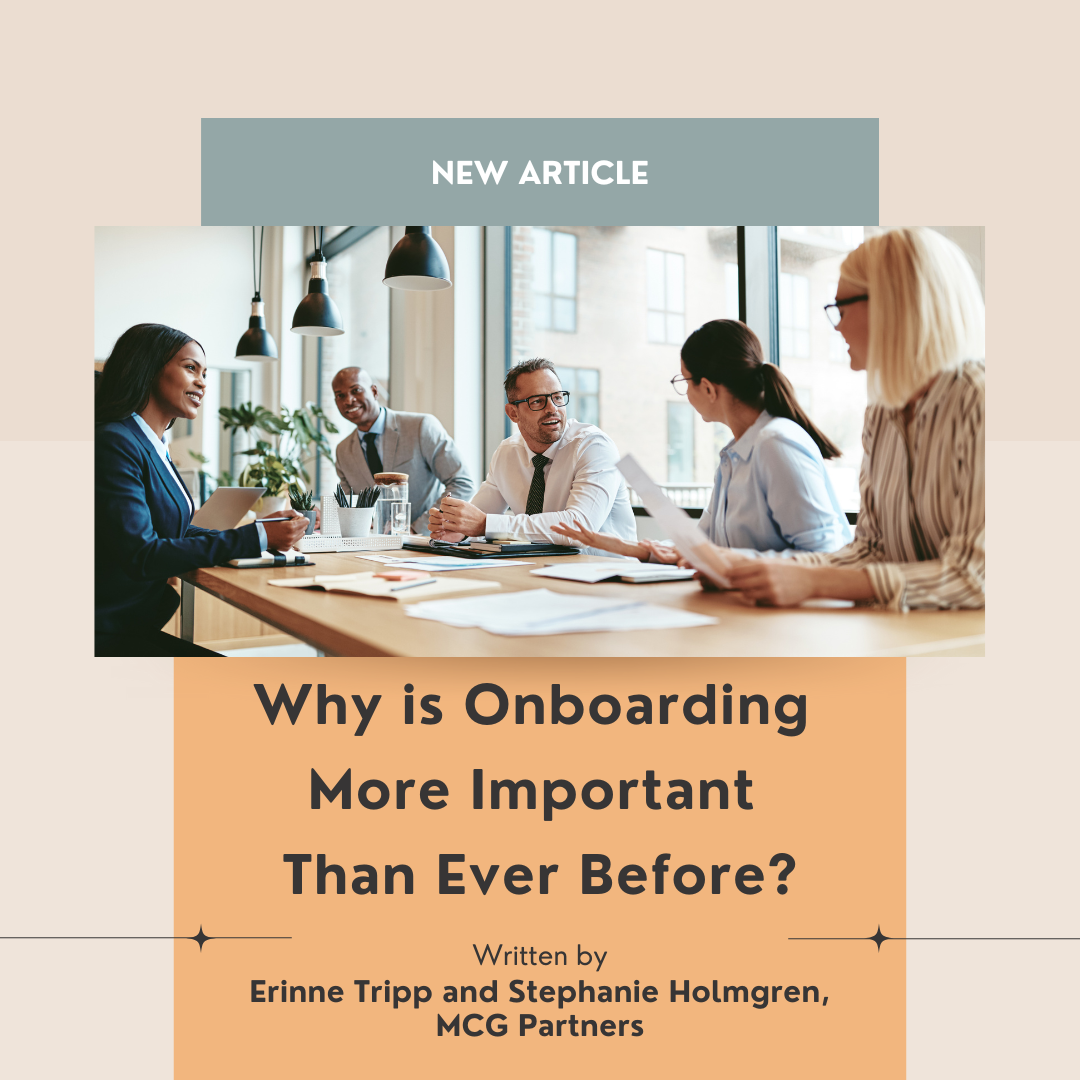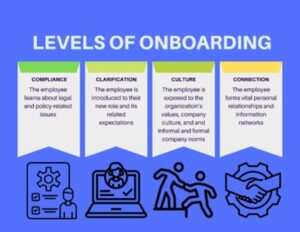
By Erinne Tripp and Stephanie Holmgren
Onboarding is the first part of an organization’s engagement, branding, and retention strategy. A new hire’s first impression and their first 90 days are the most pivotal in forming an employee’s attitude about your company’s culture, mission, leadership, opportunities for growth, team environment and more. Yet, most employers are not doing a good job of onboarding employees. According to Gallup, only 12% of American employees say their company does onboarding well! Poor onboarding is a major cause of employee turnover and has a huge impact on the organization’s bottom line, costing a company 100-300% of the employee’s salary in total.
Research by the Brandon Hall Group discovered that employers with a strong onboarding process improve new hire retention by 82% and productivity by over 70%. Effective onboarding is possible and makes a difference. So, what does effective onboarding look like and contain? There are four distinct levels of onboarding, as outlined by author Talya Bauer, Ph.D.:

We will focus on the last three:
Clarification
The faster new hires feel prepared for their jobs, the faster they will be able to successfully contribute to the firm’s mission and contribute value to the organization. In the onboarding process, review the employee’s job specifications, role, and responsibilities. What’s critical is to discuss how progress will be measured and the employee’s parameters around decision making authority. Work with your employee to establish clear expectations of performance, outlining 90- day goals and one-year benchmarks. Check in often with your employee to ensure clarity and alignment on expectations, especially as goals and even responsibilities can shift often and quickly. Lastly, ensure there is a timeline to check in and assess progress (ideally at 90-day and 6-month increments) if not done more informally.
Culture
Helping employees understand your culture requires educating them about your cultural norms—the informal and formal way things are done within the organization. Reviewing company values and expectations of behavior as early as possible with candidates and new employees will help ensure the right cultural match. This begins pre-hire, with clear expectations being set during the interview process of what the job requires.
Using the job target assessments from the The Predictive Index (PI) can help to clearly define the behavioral requirements of a job. The Predictive Index (PI) behavioral assessment can also provide prospective hires with an understanding of their own behavioral tendencies, allowing both the organization and candidate to see if there is a match between the job and the individual. The value of this data can also accelerate the onboarding process by clearly defining and identifying where behavioral adjustments may be required. This information helps the new hire understand what the organization expects and how the organization wants them to behave and act—these details are critical in guiding the new employee to adjust more quickly to the culture.
Example of topics covered in the Culture area include:
- Review company values, vision and mission
- Meeting with higher level executives to hear about goals and culture alignment
- Meetings with department heads and team leads to learn more about dynamics of teams and key stakeholders and how to best interact and communicate with them
Connection
Hybrid and remote work have highlighted the critical nature that relationships and connections play in employee engagement and satisfaction in the workplace. While connections between employees have become less structured, what hasn’t changed is the impact that feeling connected to others has on our overall levels of engagement. Trust is at the center of connection, and trust is built when employees feel they can be themselves, when they are recognized for who they are, when their voices are heard, supported, and appreciated.
Foster connection by coordinating introductory meetings for new hires to meet their colleagues and key stakeholders. Go further than simply providing the names. Using a tool like The Predictive Index can also help new employees gain self-awareness about what drives and motivates their behavior, and also offers insights into the behavioral tendencies of individuals who they will be working with. Sharing PI relationship guides and a team report with a new hire help take the guesswork out of how they should interact with their key stakeholders.
If your organization has the ability, you may even want to assign a mentor to new hires, who can show them the ropes during their first couple of months on the job. Exceptional onboarding programs give the new employee a mentor or buddy. According to Brandon Hall Group, two thirds of high-performance onboarding programs include formal mentorship and coaching.
Example of topics covered in the Culture area include:
- Understanding styles of team members and manager
- Self-awareness and reflection
- Time with close colleagues and team members
- Mentoring
A tool to build a great onboarding process
In this labor market, the candidate pool is likely small, leaving employers fewer choices when it comes to finding the right person for a job. This underlines the importance of a well-crafted onboarding process, tailored to the individual. But you might say, we bring on so many people, we don’t have time to do a proper onboarding let alone a personalized process. The solution is a tool that identifies the new hire’s strengths and areas for growth, how they fit the behaviors needed for the job and how their leader can manage these individual qualities. This tool, The Predictive Index® (PI), helps managers identify which behaviors come naturally to an individual so that, based on the role, they understand where behavioral fits and gaps may be and where adjustments could be made to be as successful in the new role as possible.
When PI is integrated into a selection process, it can help employers make better hiring decisions and set clearer job expectations. With that said, PI is only one piece of data when prioritizing candidates. Employers should also look at the skills, knowledge and experience the new hire brings, how well they fit the organizational values and culture, along with how well they match the behavioral requirements of the job.
An easy-to-use structure for managers and employees
To successfully onboard a new employee, a process is essential. We all know that. But using the same process for each new hire doesn’t necessarily support retention. Managers need a manageable structure that doesn’t add another heavy task to their already full plates. The PI, combined with simple training, can produce powerful outcomes.
If you’re looking to customize your onboarding process, The Predictive Index (PI) Behavioral assessment can help:
- New hires gain self-awareness and an understanding of the behavioral requirements of the job from the start
- Hiring managers adapt their management style to align with the behavioral needs of the new hire
- Personalize onboarding plans to align with the new employees’ natural behavioral tendencies
The Predictive Index (PI) is a valuable tool for any organization that is struggling with retention and hiring. Understanding a new hire’s behavioral tendencies can help managers tailor onboarding to the individuals’ style to help them get up to speed as fast as possible. Onboarding should not be a one size fits all process. Using tools like PI can give a new hire exactly what they need to be successful and set the foundation for the future from the start.
About MCG Partners: Purpose. Passion. Performance. Progress.
MCG Partners is a Greater Boston-based consultancy specializing in executive coaching, leadership development, talent management, organizational effectiveness, and management training solutions. MCG Partners is also a Predictive Index® (PI®) certified partner.
To learn more about MCG Partners’ services or The Predictive Index®, contact Stephanie Holmgren, [email protected] or visit mcgpartners.com.









